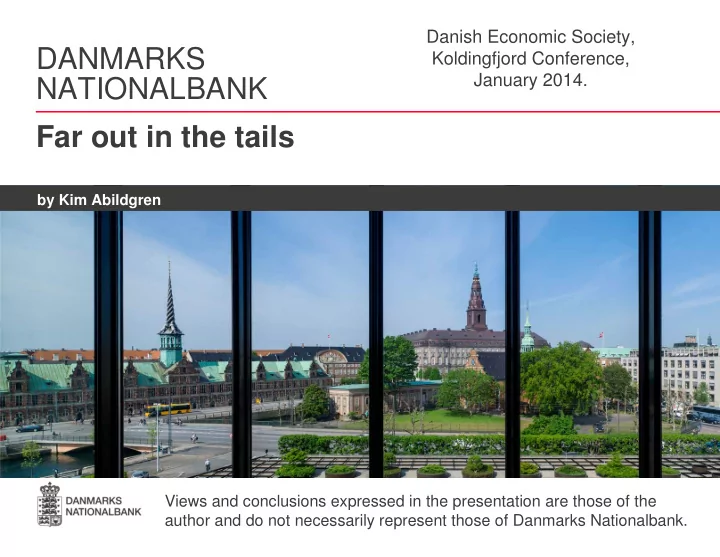

Danish Economic Society, DANMARKS Koldingfjord Conference, January 2014. NATIONALBANK Far out in the tails by Kim Abildgren Views and conclusions expressed in the presentation are those of the author and do not necessarily represent those of Danmarks Nationalbank.
2 Macro stress testing
3 The Rangvid report "... the financial crisis has exposed the limitations of the stress tests used by the authorities ..." "... the models should also be further improved in the future via new knowledge and a focus on including low-probability but high- consequence scenarios ..."
4 Real GDP growth in 2009 in Danmarks Nationalbank's hard stress scenarios
5 Limitations of traditional economic models used for macro stress tests Designed to capture average Correlation between rather than extreme macro-financial risk outcome. factors might be subject to tail dependence - The dynamic interactions estimated statistical between the financial relationships might sector and the real therefore break down economy are rich and during crises. complicated - especially the feedback effects from a An assumption of linear distressed banking sector relationships may be to the real economy. reasonable when shocks are small - non- Theoretically well-founded linearities might emerge and consistent storytelling during crisis (collateral as well as communication constraints, fire saes, might tend to generate too illiquid markets). "mild" stress scenarios.
6 A supplementary approach - tails from the past Economic history Stress tests � Economic history is rich � Might have an eye for on extreme events: the long-term historical perspective as a source � Currency crises. of inspiration when � Banking crises. designing low- � Debt crises. probability scenarios. � Base scenarios on � Severe stock-market shocks from the tail of collapses. the historical distribution of specific macro-financial risk factors.
7 Frequency distribution of year-on-year growth in real GDP
8 Frequency distribution of year-on-year growth in real exports of goods
9 Frequency distribution of year-on-year change in domestic non-bank credit in per cent of nominal GDP
10 Frequency distribution of year-on-year growth in nominal farm prices
11 Frequency distribution of year-on-year nominal growth in the total share price index
12 The use of marginal historical distributions of macro-financial risk factors in stress tests • Evaluate the likelihood of shocks studied in simple static sensitivity analyses (e.g. a 20 per cent drop in stock prices). • Identify relevant historical scenarios of interest for scenario-based stress tests (for instance the 1920s). • ” Reverse stress testing ", e.g. calculate the increase in long- term interest rates that the financial system can handle without a need for further capitalisation and use the marginal historical distributions to get an idea of the likelihood of such an increase. • Inspiration for designing "worst case" scenarios , for instance the simultaneous occurrence of the largest drop in farm prices and the largest increase in long-term interest rates that we have experienced historically.
13 What are the cons of using marginal historical distributions in stress tests • Simultaneous historical distributions would be of greater interest than marginal historical distributions of each macro- financial risk factor in isolation (However, the curse of dimensionality: 5 x 5 x 5 x 5 x 5 = 3,125). • Purely "statistical" approach without specifying and explaining those transmission channels and structural relationships that would generate “worst case” outcomes or determining the exact likelihood of the scenarios. • The key stories of stress scenarios are usually easier to tell within the framework of structural macroeconomic models. • Historical outcomes reflect public support measures.
14 The importance of simultaneous distributions - banking crises can be very different !
15 What are the pros of using marginal historical distributions in stress tests • "... the main advantages of historical scenarios is the fact that they are plausible, if only because they have occurred before, and are not as sensitive to model risk as hypothetical scenarios” (Varotto, 2012) • One can use conditional scenarios. If e.g. the focus is on the financial system's resilience to a large drop in stock prices, one could find those years where stock prices declined by 10 per cent per or more from one year to another. One could then randomly pick one of those years and use the actual historical values of all macro-financial risk factors for this year and the following years as the stress scenario. • One can use mixed scenarios based on linear combinations of historical outcomes in different periods. This could for instance be a linear combination of the outcomes from the years characterised by large drops in house prices, real GDP and real exports with the outcome from the years characterised by a large increase in long-term interest rates
16 Final remarks • Quantitative macro stress testing methodologies will no doubt remain under rapid development in many years to come. • However, there will properly always be a considerable element of choices and judgements involved in the design of proper stress scenarios. • Stress tests based on structural macro-economic models are important for storytelling in the communication of macroprudential policy initiatives. • ”Worst case" scenarios might be useful as some of the tools available within a larger suite of stress-test approaches. • Applying different approaches for stress testing provide a more robust picture of the risks faced by the financial system.
Recommend
More recommend